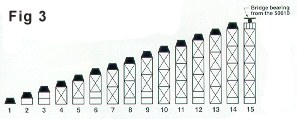The LGB Pier System
| 50612 | Single-Layer Pier - Elevates the track by 15 mm. |
| 50613 | Triple-Layer Pier - Elevates the track by 45 mm. |
| 50614 | Track Mounting Piers - Sits on top of the piers and holds the track in place. |
| 50611 | Bridge Mounting Piers - Sits on top of the piers and supports each end of the LGB 50610 bridge. |

LGB recommends that the grade of a hill be no more that 5%. ("5%" means that the track climbs 5 mm over a horizontal distance of 100 mm) LGB's standard 10000 track piece is 300 mm, so a track pier at each end of the 10000 track, raised by 15 mm, is the maximum 5% grade. For most situations, a pier would be required every 300 mm, placed where the two track pieces join (fig 2).

Each completed pier consists of one or more 50612 or 50613 modules topped off with a 50614 module. With the proper mix of 50612/50613 modules, any height of pier can be created with intervals of 15 mm.

- To create different height piers:
- The first grade piece consists of a single 50614.
- The second grade piece consists of a single 50612 (15 mm) capped with a 50614.
- The third grade piece consists to two 50612 (30 mm) capped with a 50614.
- The fourth grade piece consists of a single 50613 (45 mm) capped with a 50614.
- This pattern repeats until the desired height of the final pier is reached (fig 3).
- The piers that support the 50610 bridge are special in two ways:
- First, to offer stability, two piers are used side-by-side to support each end of the bridge.
- Second, instead of being capped with a 50614 they are capped with a 50611 Bridge Mounting Pier.
An example of what you would need for a 225 mm (8.8 inch) rise bridge system (fig 3):
| Item | Pieces | Packages | ||
| 50600 or 50610 Bridge | 1 Bridge | 1 Bridge | ||
| 50612 - Single-Layer Pier | 30 Pieces | 1 package of 36 | ||
| 50613 - Triple-Layer Pier | 68 Pieces | 1 packages of 12 | ||
| 50614 - Track Mounting Piers | 28 pieces | 1 package of 36 | ||
| 50611 - Bridge Mounting Piers | 2 pieces | 1 package of 2 |
Other Hints:
- To convert from mm to inches, divide the mm length by 25.4 (example: 15 mm = 0.59 inches)
- Make transitions between flat and steep sections gradual. Use a few short track sections to make a smooth transition.
- Keep the grade even on steep sections, with no dips and rises.
- Rolling resistance increases in curves. On real railroads, the grades are less steep in curves to compensate.
- The number of cars your locomotive can pull depends on many factors (ball bearing wheelsets have lower resistance than standard wheelsets with carbon brushes, traction is reduced on dirty and/or wet tracks, etc.)
- On steep grades, your locomotives will pull much shorter trains than on level track. On prototype mountain railroads, one locomotive often pulls just three or four cars.
- Try doubleheading (two or more locomotives) to haul longer trains.